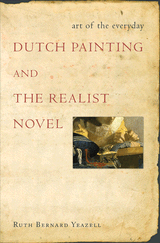
Compte rendu dans Acta fabula: Éloge du quotidien : littérature et peinture, par Marie Gueden.
Ruth Bernard Yeazell
Art of the Everyday: Dutch Painting and the Realist Novel
Princeton, Princeton University Press, 2007, 274 p.
ISBN13: 978-0-691-12726-2
RÉSUMÉ
Realist novels are celebrated for their detailed attention to ordinary life. But two hundred years before the rise of literary realism, Dutch painters had already made an art of the everyday--pictures that served as a compelling model for the novelists who followed. By the mid-1800s, seventeenth-century Dutch painting figured virtually everywhere in the British and French fiction we esteem today as the vanguard of realism. Why were such writers drawn to this art of two centuries before? What does this tell us about the nature of realism?
In this beautifully illustrated and elegantly written book, Ruth Yeazell explores the nineteenth century's fascination with Dutch painting, as well as its doubts about an art that had long challenged traditional values.
After showing how persistent tensions between high theory and low genre shaped criticism of novels and pictures alike, Art of the Everyday turns to four major novelists--Honoré de Balzac, George Eliot, Thomas Hardy, and Marcel Proust--who strongly identified their work with Dutch painting. For all these writers, Dutch art provided a model for training themselves to look closely at the particulars of middle-class life.
Yet even as nineteenth-century novelists strove to create illusions of the real by modeling their narratives on Dutch pictures, Yeazell argues, they chafed at the model. A concluding chapter on Proust explains why the nineteenth century associated such realism with the past and shows how the rediscovery of Vermeer helped resolve the longstanding conflict between humble details and the aspirations of high art.
TABLE DES MATIÈRES
List of Illustrations ix
Acknowledgments xiii
Preface xv
Chapter One: The Novel as Dutch Painting 1
Chapter Two: Low Genre and High Theory 24
Chapter Three: Balzac's Bourgeois Interiors and the Quest for the Absolute 58
Chapter Four: George Eliot's Defense of Dutch Painting 91
Chapter Five: Hardy's Rural Painting of the Dutch School 125
Chapter Six: Proust's Genre Painting and the Rediscovery of Vermeer 162
Notes 195
Index 243
BIOGRAPHIE
Ruth Bernard Yeazell is the Chace Family Professor of English and director of the Lewis Walpole Library at Yale University. Her books include, most recently, Harems of the Mind: Passages of Western Art and Literature.
Review
George Levine, author of "The Realistic Imagination" : Art of the Everyday is a work of extraordinary scholarship that significantly expands our understanding both of realism and of Dutch painting. All the big subjects related to realism are here, all handled with utmost care. One of the most satisfying things about this learned, insightful book is that it gives the impression of absolute saturation in the art and in the fictions, and thus it earns its authority in both fields.
Kate Flint, author of "The Victorians and the Visual Imagination" : I tremendously enjoyed reading Art of the Everyday. One of the great pleasures it offers is the revisiting of something commonly assumed to be self-evident--the comparison between realist fiction and Dutch art. Ruth Yeazell makes us realize just how blind we've been to the range of implications this comparison carries with it. Lucid, knowledgeable, and extremely readable, this exciting book deepens our understanding of all that's at stake in the cultural politics of realism.
Martha Hollander, author of "An Entrance for the Eyes: Space and Meaning in Seventeenth-Century Dutch Art" : Extremely thorough and precise but written with elegance and fluidity, Art of the Everyday is an excellent and entertaining book that impressively integrates the art-historical and the literary.